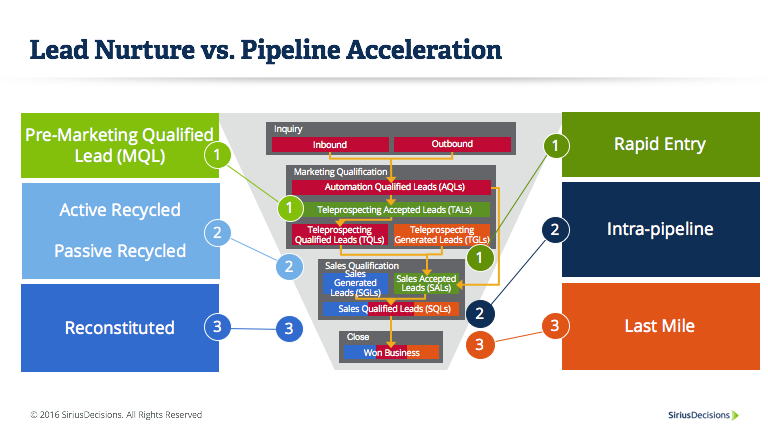Lead Nurture and Pipeline Acceleration: What’s the Difference?
- Both lead nurture and pipeline acceleration efforts make the lead management process, from cold to close, more efficient and effective
- Both lead nurture and pipeline acceleration at times address both leads and sales opportunities
- The critical dynamic that separates lead nurture and pipeline acceleration is the sales team’s active involvement (or lack of involvement)
Both lead nurture and pipeline acceleration efforts are designed to make the lead management process, from cold to close, more efficient and effective. Improving the quality of buyer engagement and the time to close, these two areas receive and deserve a lot of marketing investment and consideration. However, understandable confusion may exist as to the precise nature and definition of both types of activities as both, at times, address both leads and sales opportunities.

- The most common form of lead nurture enhances the quality of an initial inquiry to produce a lead that reaches an agreed-upon threshold before it is passed to sales. We call this pre-MQL nurture.
- Further, many companies’ marketing teams set up nurture streams to treat those leads that return from sales owing to a) active sales rejection/disqualification or b) passive rejection owing to lack of sales followup within an agreed time frame. We call this recycling nurture.
- Finally, reconstituted lead nurture calls for marketing to treat lost or abandoned sales opportunities that sales is no longer actively pursuing. One key consideration is that most cases, and within the confines of service-level agreements, marketing undertakes nurture independent of any direct sales involvement. In these cases, sales is either not the owner of the lead/opportunity or has given up interest or ownership. To improve the effectiveness of a nurture activity, sales should support marketing’s efforts by providing disqualification reasons and may initiate small-net fishing exercise. However, lead nurture is mainly initiated, planned and executed by the marketing function.
Pipeline acceleration, on the other hand, demands full joint sales and marketing involvement, commitment, alignment and participation from beginning to end. When it comes to pipeline acceleration, we at SiriusDecisions talk of three core areas, or pipeline zone-focused programs. These are:
- Rapid-entry. Periodic efforts to fill the top of the pipeline with highly targeted, pre-qualified leads that have a much greater propensity to qualify through to stage one status.
- Intra-pipeline. The creation of pinpointed offers and sales enablement assets designed to keep current opportunities moving on a trajectory toward close. Intra-pipeline efforts kick in once an opportunity has been assigned a monetary value and anticipated close date.
- Last-mile. Offers designed to drive positive interactions with late-stage opportunities that when combined can provide a push across the closing finish line.
Rapid entry targets accounts with perceived interest before an official sales opportunity is created. This action may be supported by leveraging predictive analytics for opportunity scoring, which augments estimates of how likely a prospect is to buy, along with purchase timing and deal value. Ultimately, both marketing and sales agree on potential account lists and prospects that show a high propensity to generate high quality opportunities in the near future. This work takes place outside the official sales pipeline but requires the full and active engagement of sales and marketing. Intra- and last-mile pipeline activity applies directly to opportunities that are currently within the sales pipeline and therefore demand joint sales and marketing alignment.
Thus, the critical dynamic that separates lead nurture and pipeline acceleration is the presence or absence of involvement from an active and interested the sales team.
